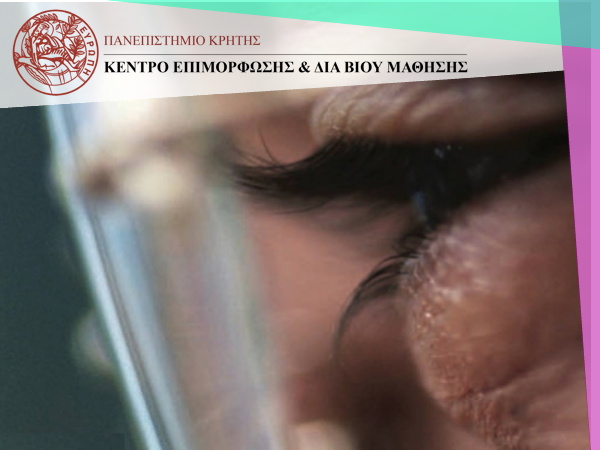Το Κέντρο επιμόρφωσης και Δια Βίου Μάθησης (Κ.Ε.ΔΙ.ΒΙ.Μ) του Πανεπιστημίου Κρήτης διοργανώνει ασύγχρονo εξ αποστάσεως επιμορφωτικό πρόγραμμα (Open courses) με τίτλο: «Ophthalmic Optics, Contact Lenses and Visual Perception: an optometric approach».


It is evident that the quality of clinical service provided by an eye care practitioner is a function of his/her clinical skills and the provision of state-of-the-art instrumentation facilities and ophthalmic products. The pace of technological and scientific development is much faster today than it was 50 years ago. In the past, when an innovative idea was proposed by a scientist or clinician it was usually followed by a lengthy period of development before any direct application was attempted. This relatively long transitional period allowed widespread discussion of the idea before any practical application was attempted, so that any outcome could be smoothly integrated into clinical practice. In contrast, today’s academic and commercial pressures frequently force premature publication and exploitation of new ideas, methods and therapeutic interventions.
Thus, the eye care practitioner, and especially the optometrist, should be equipped with basic knowledge about visual function and functional vision and have full understanding of cutting-edge technology to diagnose, evaluate and manage any refractive condition and decide on the interventions needed to optimise / rehabilitate visual performance.
This course offers a range of basic and advanced knowledge on ophthalmic optics, contact lenses and new technologies for evaluating and correcting visual performance that can bridge the gap between scientific interpretations and patients’ needs, satisfaction and complaints, offering to the eye care practitioner an ongoing search for improved methods of diagnosis and rehabilitation.
|
Κόστος συμμετοχής
|
500€
|
|
Τρόπος καταβολής τελών (Άπαξ /Δόσεις)
|
Άπαξ
|
Για περισσότερες πληροφορίες παρακαλώ πατήστε εδώ
- Αναλυτική παρουσίαση διδακτικών ενοτήτων προγράμματος
|
Τίτλος διδακτικής ενότητας
|
Ώρες διδασκαλίας (e-learning)
|
Α/Α & τίτλος Εκπαιδευτικών Υποενοτήτων
|
Μαθησιακά αποτελέσματα
|
|
1. Ophthalmic optics & visual perception
|
2
|
1. Human visual perception and natural selection
|
Γ
|
| |
2
|
2. Τhe eye as an optical system - Imaging the human eye
|
Γ
|
| |
2
|
3. The optical structures and the aberrations of the eyes
|
|
| |
2
|
4. Emmetropisation and myopia progression: a refractive error or a disease?
|
Γ + Ψ + Σ
|
| |
2
|
5. Accommodative function: “errors” in focus, fluctuations and dynamics
|
Γ
|
| |
2
|
6. Gaze, eye movements and fixation.
|
Γ
|
| |
2
|
7. Wavelengths, colour perception and colour anomaly
|
Γ
|
| |
2
|
8. Phantoms in the visual brain
|
Γ + Σ
|
| |
2
|
9. Binocular vision: summation vs. rivalry
|
Γ
|
| |
2
|
10. Evaluating visual performance: visual acuity, contrast sensitivity and beyond threshold
|
Γ + Ψ
|
| |
2
|
11. Ageing of the human eye: optics vs. perception
|
Γ
|
| |
2
|
12. Presbyopia: why does it come so early in our life?
|
Γ
|
| |
2
|
13. Correcting presbyopia: progressive power lenses
|
Γ + Ψ + Σ
|
|
2. Contact lenses
|
2
|
14. Contact lenses in 2020: where are we heading?
|
Γ
|
| |
2
|
15. Optics of contact lenses: what should we know?
|
Γ
|
| |
2
|
16. Corneal topography: normal vs. irregular cornea
|
Γ + Ψ
|
| |
2
|
17. Correcting astigmatism with contact lenses: soft vs RGP
|
Γ + Ψ + Σ
|
| |
2
|
18. Fitting a presbyope with contact lenses: multifocals vs. monovision
|
Γ + Ψ + Σ
|
| |
2
|
19. Myopia control and its clinical importance: orthokeratology vs. extended DOF CLs
|
Γ + Ψ + Σ
|
| |
2
|
20. Fitting the irregular cornea with contact lenses: corneal vs. semi-scleral / scleral
|
Γ + Ψ + Σ
|
|
3. Visual rehabilitation
|
2
|
21. Surgical correction of refractive error and keratoconus
|
Γ + Ψ + Σ
|
| |
|
22. Correcting refractive error and presbyopia with surgical techniques
|
|
| |
2
|
23. Ocular disease: acquired vs. inherited pathologies
|
Γ + Ψ
|
| |
2
|
24. Low vision patients: how to improve their visual experience
|
Γ + Ψ + Σ
|
| |
2
|
25. Visual electrodiagnosis in retinal and post-retinal disease
|
Γ + Ψ + Σ
|
Μετά την ολοκλήρωση παρακολούθησης των βίντεο, ακολουθεί η διαδικασία συμπλήρωσης ενός τεστ αυτο-αξιολόγησης με 25 ερωτήσεις multiple choice.
Για πεισσότερες πληροφορίες παρακαλώ πατήστε ΕΔΩ
Εκπαιδευτές
Επιστημονικός υπεύθυνος: Καθ. Μιλτιάδης Τσιλιμπάρης
Ακαδημαΐκός υπεύθυνος: Δρ. Σωτήρης Πλαΐνης
Διδάσκοντες: Σ. Πλαΐνης, Μ. Τσιλιμπάρης, Ε. Δετοράκης, Σ. Παναγοπούλου, Α. Παλλήκαρης, Γ. Κυμιωνής, Π. Σαπουντζής





